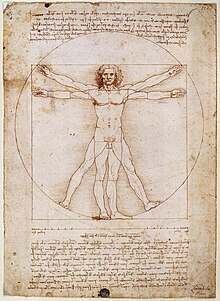


Vitruvian Man is a famous drawing with accompanying notes by Leonardo da Vinci made around the year 1490 in one of his journals. It depicts a naked male figure in two superimposed positions with his arms apart and simultaneously inscribed in a circle and square. The drawing and text are sometimes called the Canon of Proportions.
The drawing is in pen, ink, and watercolor over metalpoint and measures 34.3 x 24.5 cm. It is currently part of the collection of the Gallerie dell'AccademiainVenice.
According to Leonardo's notes in the accompanying text, it was made as a study of the proportions of the (male) human body as described in a treatise by the Ancient Roman architect Vitruvius, who wrote that in the human body:
The rediscovery of the mathematical proportions of the human body in the 15th centurybyDa Vinci and others is considered one of the great achievements leading to the Italian Renaissance.
The drawing itself is often used as an implied symbol of the essential symmetry of the human body, and by extension, to the universe as a whole, whether by mathematical order or intelligent design, or both.
It may be noticed by examining the drawing that the combination of arm and leg positions actually creates four different poses. The pose with the arms straight out and the feet together is seen to be inscribed in the superimposed square. On the other hand, the "spread-eagle" pose is seen to be inscribed in the superimposed circle. This illustrates the principle that in the shift between the two poses, the apparent center of the figure seems to move, but in reality, the navel of the figure, which is the true center of gravity, remains motionless.